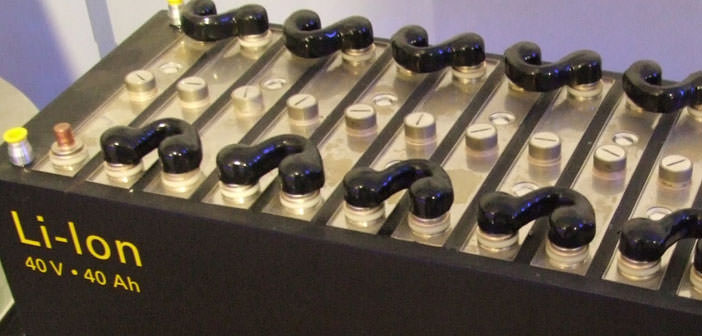A group of researchers published a study in Science to demonstrate the possibility of making a lithium-ion battery using an aqueous electrolyte, increasing the stability and security apparatus.
Rechargeable, high storage capacity and low energy discharge energy when not in use: the lithium-ion batteries have brought an important contribution to the world of electronics allowing us all to appreciate the benefits in life everyday.
However, these accumulators are still surrounded by a halo of distrust, especially for safety and reliability. Concerns in this direction have concentrated on electrolytes that are used in this type of batteries, which are often highly flammable, reactive with other components used in the batteries (the electrodes, for example) and made of materials with a certain degree of toxicity (such as lithium salts). The consequence is the limitation of the range of possible applications and the adoption of phases and expensive processes during the production of the batteries.
In a study published in Science, we try to give an answer to the problem with the use of an aqueous electrolyte. In the past, the use of this type of electrolyte has been limited, since they present a window of electrochemical stability – that is, the range of potential difference in which the battery materials do not oxidize and do not reduce – rather narrow. This causes the degradation of the structure of the electrodes due to the development of hydrogen at the anode.
If it is used a nonaqueous electrolyte, both electrodes are homogeneously functional on a wider window and this follows the formation of a layer of solid electrolyte on the electrode surface, which constitutes a barrier that allows movement of the ions and prevents other hand, movement of electrons. This step is formed when a part of the electrolyte decomposition in the initial charge.
The layer is not formed in an aqueous electrolyte because the decomposition of water results in the formation of molecules H2, O2 or OH-, none of which is deposited on the electrode surface. The lack of a solid-electrolyte interface limits the voltage and energy density in lithium-ion battery with aqueous electrolyte, respectively lower than 1.5 V and 70 Wh/kg.
In the study in Science describes a way to control the decomposition of the electrolyte aqueous medium to form the solid-electrolyte interface. In order to obtain this result it is necessary to find a lithium salt by the high solubility and stability in water and, even more important, capable of accepting electrons at a specific potential to give rise to a reaction capable of producing a solid product insoluble in water. Few lithium salts have these requirements, and researchers focused on LiTFSI.
The researchers created a solution of LiTFSI to a high concentration (with molarity greater than 20): in other words numerically ions Li+ exceed the water molecules. This solution of ” salt water ” shows unusual behavior precisely because of a considerably high amount of ions. The interactions between the ions Li+ are more common than regular water-ion interactions found in saline solutions. Thanks to the increase of interactions, Li+ ions are able to form a dense interphase surrounding the anode where electrons can gain. Thanks to this interface the electrochemical stability grows to about 3 Volts.
The thermal analysis of soluzoni to 20:21 mol from room temperature to -90°C have shown that the solutions are still considerable as true liquids, that is, the molecules that compose them do not show any specific sort order. At room temperature, the conductivity of the solution to 21 moles is comparable to that of a nonaqueous electrolyte used in the lithium-ion batteries commonly in commerce. The researchers also noted that the increase in the concentration of LiTFSI leads to enlargement of the window of electrochemical stability. High concentrations of LiTFSI reduce the water activity, modulate the redox potential and suppress the decomposition of the water thanks to the formation of a solid-electrolyte interface specification.
By various analytical techniques, the researchers were able to demonstrate the existence of the electrolyte interphase watery. The analysis allowed the team to develop an understanding of the ” sheath ” of Li+ions and its role in the chemistry of the interphase. In a solution at a concentration lower than 5 moles water, it is present in abundant quantities and is capable of forming an ion sheath around Li+ and TFSI–, each surrounded by four water molecules. Increasing the concentration of the salt will come to a point, higher than 10 moles, where the water is not present in sufficient quantity to create this sheath.
With a solution to 21 moles salt concentration, it is well beyond this point and in the solution, there are 2.6 molecules of water for each ion Li+. In this situation, the water is not able to neutralize the electrostatic field created by the positive charge of the ions of lithium. The excess positive charge attracts then TFSI negative ions that penetrate into the sheath part and interact with the ions Li+. This interaction leads to a reduction of the ions at the anode TFSI– that release fluoride going to form lithium fluoride. The lack of free molecules of water goes to reduce the electrochemical activity going to improve the stability limits of both electrodes.
The researchers built a cell lithium-ion battery with electrodes of lithium-manganese oxide (LiMn2O4) to the cathode and molybdenum sulphide (Mo6S8) anode. These cells have shown excellent stability, high retention capacity and Coulomb efficiency of 100%.
(Image form Wikipedia.org)

